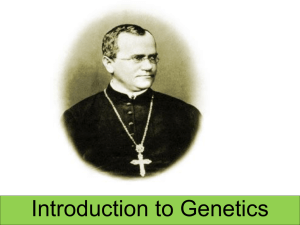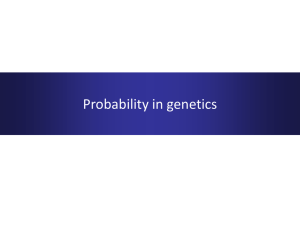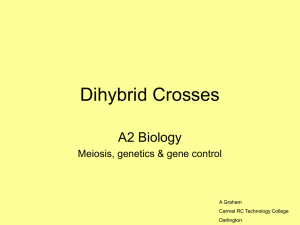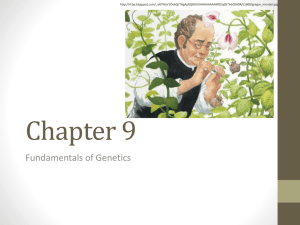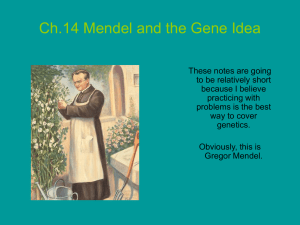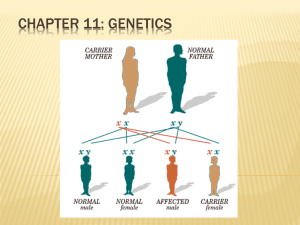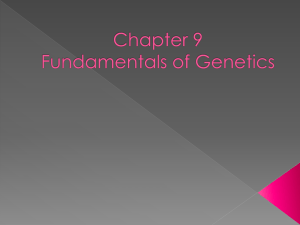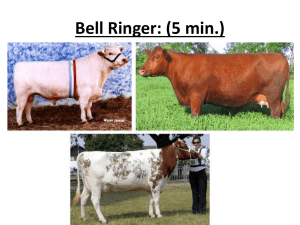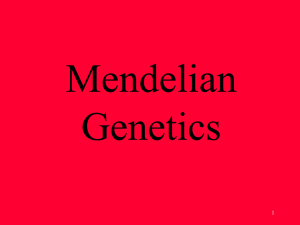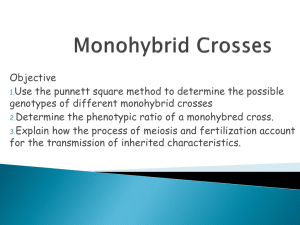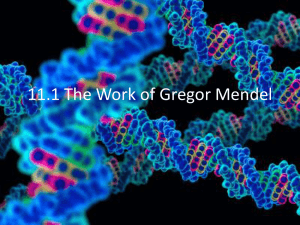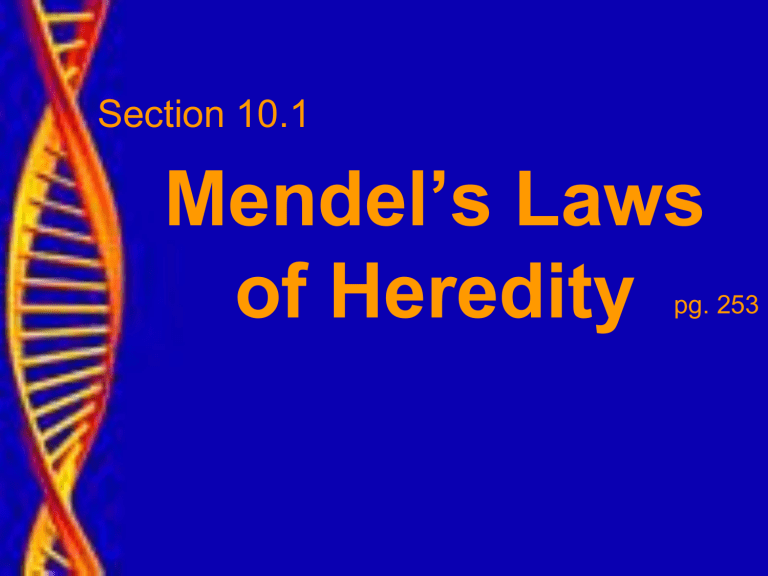
Section 10.1
Mendel’s Laws
of Heredity
pg. 253
WHY MENDEL SUCCEEDED
Gregor Mendel (1822-1884)
Austrian Monk known as the “father
of modern genetics”
Found that inheritance follows
certain laws later known as
Mendel’s Laws of Inheritance
Heredity is the passing on of
characteristics from parent to
offspring
Inherited characteristics are called traits (factors)
The branch of biology that studies heredity is called
genetics – which was founded upon the rediscovery
of his work.
WHY MENDEL SUCCEEDED
Mendel’s pea plant collection
contained around 28,000 plants
Pea plants reproduce sexually by
producing male and female sex
cells (gametes)
Male gamete forms in pollen
Female gamete formed in ovary
Fertilization occurs when the
male gamete unites with the
female gamete
Pollination is the transfer of
pollen to ovary in a plant –
Remove male parts
normal reproduction.
Snipping the stamen could prevent self-pollination
Flower parts
A similar figure is in the book on pg. 642
WHY MENDEL SUCCEEDED
Cross-pollination is transferring pollen of one
plant to the ovary of another plant
• Mendel did this to get certain plants to breed with
others to be sure of the parents
• Mendel was very careful with all of his work
Figure 10.1
MENDEL’S MONOHYBRID CROSSES
Mendel was able to create tall
Figure 10.2
plants and short plants
(purebreds)
P1
• He referred to the offspring of
a purebred tall and a purebred
short as a hybrid
Short pea plant
Tall pea plant
• Crossing a 6’ tall plant with a
2’ tall (short) plant resulted in
all 6’ tall plants
F1
• Crossing the hybrid offspring
All tall pea plants
resulted in 75% tall and 25%
short
• P1 refers to the “Parental F2
generation”
• F1 (“Filial”) refers to the
3 tall: 1 short
offspring
MENDEL’S MONOHYBRID CROSSES
So what does MONOHYBRID refer to?
Referring to figure 10.3:
• When Mendel crossed a purebred tall with a
purebred short he got all tall plants
• When he crossed a purebred purple flower with a
purebred white flower he got all purple flowers
• He referred to the trait that was observed in these
cases as ___________.
• The trait that seemed to “disappear” he called
_____________.
• Mendel concluded that these plants have “factors”
that control each of the traits (color, shape, height)
• We call these factors genes (parts of DNA)
• Alternative forms of genes (tall vs. short or yellow
vs. green) are known as alleles.
Figure 10.3
Seed
color
Pod
color
Pod
shape
Flower
color
Flower
position
round yellow purple
axial
(side)
green
inflated
terminal
(tips)
yellow
constricted
Seed
shape
Plant
height
Dominant
trait
tall
Recessive
trait
wrinkled green
white
short
MENDEL’S MONOHYBRID CROSSES
These two alleles for each P1
trait can be expressed as a
single letter
For plant height we can use
the letters “T” & “t”
Dominant allele is ___.
Tall plant
Short plant
Recessive is ___.
Mendel’s purebred tall
F1
plants were “TT”
His purebred recessive
plants were “tt”
Fill in the blanks in the
figure to the right which t
All tall plants
goes where? T TTT t t t
MENDEL’S MONOHYBRID CROSSES
Mendel concluded that the allele (gene form) of tall
plants was dominant to the allele for short plants
Confirming that the plants had two alleles for each
trait (TT = Tall, Tt = Tall, or tt = short)
Knowing that traits are inherited from parents, he
also concluded that these alleles are inherited
However a plant can only get one allele from each
parent
The gametes (sex cells) contained either one or the
other form of the gene (T or t)
The Law of _________________ states that every
individual has two alleles of each gene and when
gametes are produced, each gamete receives one
of these alleles.
T
PHENOTYPES AND GENOTYPES
It’s vocab time…
Phenotype refers to the organism’s physical
characteristic (what you can see) Ex: Tall
Genotype refers to the organism’s genetic makeup
(what you can’t see) Ex: TT or Tt
Homozygous/purebred represents two alleles that
are the same (TT or tt)
Heterozygous/hybrid organisms have different
alleles (Tt)
How are we going to distinguish Homo and Hetero?
Law of Dominance states that hybrid organisms (Tt)
will express the dominant allele (ex: tall).
PUNNETT SQUARES
1905 - Reginald Punnett devised an easy way to find
expected genotype proportions of offspring from
known parent genotypes based off Mendel’s laws
Monohybrid Cross
(one trait)
Heterozygous
tall parent
T
T
T
T
t
T t
Heterozygous
tall parent
t
T
t
t
t
T
TT
Tt
t
Tt
tt
G= 50% Tt : 25% TT : 25% tt
P= 3 Tall : 1 short
PUNNETT SQUARES
Monohybrid crosses are easy to separate alleles
according to Mendel’s Law of Segregation
If we have heterozygous parents (Tt X Tt) we can
just separate the T from the t
For Dihybrid crosses, the gamete separation is a
little tricky
If we have two parents that are heterozygous for
seed shape (Rr) and seed color (Yy) their
genotype is RrYy
To separate alleles into gametes we use the FOIL
method from algebra
Round
Yellow
Round
green
wrinkled
Yellow
RrYy makes four different gametes
Using the FOIL method we get…
RY
Ry
rY
ry
wrinkled
green
MENDEL’S DIHYBRID CROSSES
Mendel also crossed plants with two different traits
Round=R, wrinkled=r & Yellow=Y, green=y
What is the genotype of a purebred (homozygous)
plant with Round Yellow seeds? RRYY
What is the genotype of a purebred (homozygous)
plant with wrinkled green seeds? rryy
Purebred (homozygous) Round Yellow seeds
X Purebred (homozygous) wrinkled green seeds
Result of F1…All plants had Round Yellow seeds
However crossing the Dihybrid F1 gives a ratio of
9:3:3:1
Which leads us to Mendel’s second law…
The Law of __________________ states that
genes for different traits are inherited independently
of each other.
Round Yellow (RRYY) X wrinkled green (rryy)
P1
wrinkled green
Round Yellow
F1
All Round Yellow
F2
9
Round Yellow
R_Y_
3
Round green
R_yy
3
wrinkled Yellow
rrY_
1
wrinkled
green
rryy
Gametes from RrYy parent
Starting here
what are the
gametes?
rY
ry
RY
Ry
RRYY
RRYy
RrYY
RrYy
RRYy
RRyy
RrYy
Rryy
RrYY
RrYy
rrYY
rrYy
RrYy
Rryy
rrYy
rryy
RY
Ry
Gametes from
RrYy parent
rY
ry
PROBABILITY
Knowing the parents genotype we can predict the
probable offspring genotype and phenotype
What is the probability of having Rr offspring? 50%
What is the probability of having Round offspring? 75%
r
R
RR
Rr
Rr
rr
R
r
PROBABILITY
Given the parents genotype and number of offspring,
you should be able to predict the number of each
genotype and phenotype.
PROBABILITY PROBLEM
R=Round seeds & r=wrinkled seeds
1. P1 genotype: RR X rr
2. All of the F1 offspring will be ______.
3. Assume 140 F2 offspring are created from F1.
4. ________ will have their parents (F1) genotype.
5. ________ will have Round seeds.
6. ________ will have wrinkled seeds.
7. ________ will have the same genotype as the P1.
PROBABILITY PROBLEM (#2)
2. All of the F1 offspring will be ______.
P1=RR X rr (always put first parent on top of square)
R
R
Rr
Rr
Rr
Rr
r
r
Rr (Round)
2. All of the F1 offspring will be ___________.
PROBABILITY PROBLEM (#4)
4. ________ will have their parents (F1) genotype.
F1= All Rr
R
RR
r
Rr
R
Rr
rr
# of F2 Offspring = _____
140
Expected % of genotype
(Rr) that is same as
50%
parents= ______
70
50% (2/4) of 140 = _____
140 X .5 = 70
r
70 will have their parents (F1) genotype.
4. ________
PROBABILITY PROBLEM (#5)
5. ________ will have Round seeds.
R
r
R
RR
Rr
r
Rr
rr
# of F2 Offspring = _____
140
Expected % of Round
75%
phenotype = ______
105
75% (3/4) of 140 = _____
140 X .75 = 105
105 will have Round seeds.
5. ________
PROBABILITY PROBLEM (#6)
6. ________ will have wrinkled seeds.
R
r
R
RR
Rr
r
Rr
rr
# of F2 Offspring = _____
140
Expected % of wrinkled
25%
phenotype = ______
35
25% (1/4) of 140 = _____
140 X .25 = 35
35 will have wrinkled seeds.
6. ________
PROBABILITY PROBLEM (#7)
7. ________ will have the same genotype as the P1 (RR or rr).
R
r
R
RR
Rr
r
Rr
rr
# of F2 Offspring = _____
140
Expected % of RR or rr
50%
genotype = ______
70
50% (2/4) of 140 = _____
70 will have the same genotype as the P1.
7. ________
Actual Results of Mendel’s Work

